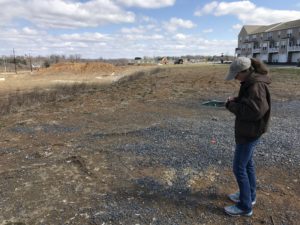Information Overload! Why the Definition of “Reasonably Ascertainable” is Changing Rapidly in Environmental Due Diligence
Information Overload! Why the Definition of “Reasonably Ascertainable” is Changing Rapidly in Environmental Due Diligence

A Liberty Environmental Scientist visits a residential development site as part of a Phase I Environmental Site Assessment in Lancaster, Pennsylvania.
Social media, and the information age in general, has connected us in ways that were unimaginable when many us began in the environmental business. I recall the difficulties of sharing a single PC among a staff of five in a cramped office in 1992; the novelty of Windows when it was purchased by our company a year later, and the utter joy over a company-wide internet connection – a technological wonder! – on my first day at a new job in the late 1990s.
In those days, collecting information about a site required real legwork, and the completion of a single Phase I Environmental Site Assessment meant some sweat equity. There was the trip to the County Courthouse and its Tax Assessment Office for parcel information, then the Recorder of Deeds office for the cumbersome chain-of-title research. Then, there was often a separate trip to the County Planning Commission for aerial photographs, and yet another drive to the County Agricultural Extension office or the local Conservation District office for soil, geologic, and other physical setting data. In Philadelphia in the 1990s, I was on a first-name basis with the Free Library’s mapping archivist, the gatekeeper to the only reliable source of detailed historical maps in the city. It all amounted to quite an effort, but as a result of the limited availability of records there was a clear line of demarcation between what data you could collect and what you couldn’t. If it was available within the project timeline and you could go get it, you did. Often, you were left with less data than you hoped to collect, but it represented what was reasonably ascertainable at the time.
How times have changed. Liberty’s younger professionals cringe when I tell them of the miles I logged for a single ESA, of the piles of quarters I kept in the car for parking meters and pay phones, and – this actually gets a chuckle – the stack of County Atlases on the passenger seat to keep from getting lost somewhere in southern Delaware County. It’s a shock because nearly every conceivable resource that we used to chase down with great effort is now available through a simple online search or ordering system. From historical aerial photographs to fire insurance maps, deeds to liens, topographic maps to tank registrations, it’s mostly available at the click of a button and a subscription payment. And thus, within the context of environmental due diligence, there has been a re-evaluation of what information is now reasonably ascertainable and, perhaps more to the point, practically reviewable.
Thankfully, each of these terms is clarified under ASTM Standard Practice E1527-13 for Phase I Environmental Site Assessments. In essence, if the data is relatively easy to search using standard efforts, it’s reviewable. More to the point, there are a number of examples that the Standard definition describes that it considers not practically reviewable – such as large numbers of records that are searchable only across large geographic areas, or databases that can only be screened through chronological entries. But in the short period of time between the publishing of the current ASTM Standard in late 2013 and now, such circumstances are rapidly disappearing. Once-obscure map records are now easily viewable in your browser on public agency websites backed by GIS-based applications, regulatory databases have become more robust and searchable, and archived agency records are being digitized quickly in all states.
The takeaway of all this for environmental professionals is that we must keep ahead of the information curve and be sure to collect all information that is reasonably ascertainable and practically reviewable within the definitions set forth in our industry’s standards of practice. Periodic updates of the ASTM Standard or others, as current as they may be, may not be able to keep up with the changing nature of this definition in the information age. More data is available to us now than ever before, so more data is expected to be collected, reviewed and evaluated within the scopes of our assessments. Is this a good thing? Sure. And it’s exciting to have so much information at our fingertips, that’s for certain. But I will admit to a certain wistfulness for those great old courthouses, and I still keep a stack of quarters in my glove compartment – just in case.
This article was written by David S. Coyne, Principal, as part of a series of news posts on environmental due diligence studies. To read other articles, please visit our news page.